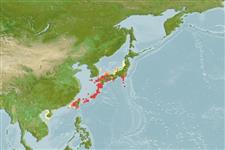Common names from other countries
>
Gobiiformes (Gobies) >
Gobiidae (Gobies) > Gobiinae
Etymology: Eviota: No etymology given, suggested by Christopher Scharpt: from Latin 'eu' for 'true' and 'iota' for anything very small, in combination 'truly very small' referring to it as being the smallest vertebrate at the time it has benn described by Jenkins (thus, making the suggestion by Scharpt plausible.; specca: Name based on the Anglo/Saxon 'specca' for speckled, referring to the heavy speckling of chromatophores over the body; noun in apposition.
Environment: milieu / climate zone / depth range / distribution range
экология
морской; пределы глубины 5 - 14 m (Ref. 95167). Subtropical
Northwest Pacific: Japan, Ryukyu Is..
Size / Вес / Возраст
Maturity: Lm ? range ? - ? cm
Max length : 1.2 cm SL самец/пол неопределен; (Ref. 95167)
Краткое описание
определительные ключи | морфология | морфометрия
колючие лучи спинного плавника (общее число) : 7; членистые (мягкие) лучи спинного плавника (общее число) : 8; колючие лучи анального плавника: 1; членистые (мягкие) лучи анального плавника: 8; позвонки: 26. This species is distinguished from its congeners by the following set of characters: cephalic sensory pore system pattern 1 (complete); 8/8 dorsal/anal-fin formula; body heavily sprinkled with chromatophores; upper pectoral-fin base pigmented; 4 subcutaneous body bars between anal-fin origin and caudal-fin base; occipital spot absent; pale opercular membrane; first dorsal fin sprinkled with small melanophores and chromatophores; caudal peduncle with no distinct dark spot or bar; cheek crossed by dark lines, red spots absent (Ref. 95167).
Life cycle and mating behavior
Maturities | размножение | Spawnings | Egg(s) | Fecundities | личинки
Greenfield, D.W., T. Suzuki and K. Shibukawa, 2014. Two new dwarfgobies of the genus Eviota from the Ryukyu Islands, Japan (Teleostei: Gobiidae). Zootaxa 3774(5):481-488. (Ref. 95167)
Статус Красного Списка МСОП (Ref. 130435)
CITES (Ref. 128078)
Not Evaluated
Угроза для людей
Harmless
Использование человеком
дополнительная информация
инструменты
Специальные отчеты
Скачать в формате XML
ресурсы в Интернет
Estimates based on models
Preferred temperature (Ref.
115969): 20.5 - 26.3, mean 23.3 (based on 102 cells).
Phylogenetic diversity index (Ref.
82804): PD
50 = 0.5000 [Uniqueness, from 0.5 = low to 2.0 = high].
Bayesian length-weight: a=0.00708 (0.00333 - 0.01504), b=3.09 (2.92 - 3.26), in cm Total Length, based on LWR estimates for this (Sub)family-body shape (Ref.
93245).
Trophic level (Ref.
69278): 2.9 ±0.3 se; based on size and trophs of closest relatives
устойчивость к внешним воздействиям (Ref.
120179): высокий, минимальное время удвоения популяции до 15 месяцев (Preliminary K or Fecundity.).
Fishing Vulnerability (Ref.
59153): Low vulnerability (10 of 100).
